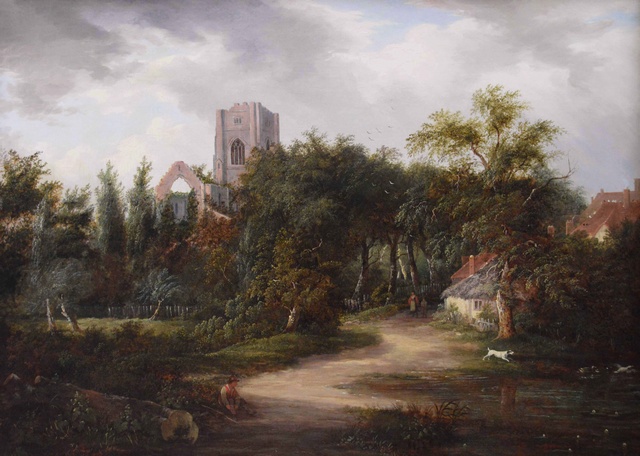Edward Williams
British, (1781-1855)The Old Abbey Ruins
Oil on canvas
Provenance: Frost & Reed; Cider House Galleries
A wonderful landscape painting of Abbey ruins seen from a village by Edward Williams. In the foreground, a figure is shown resting by a village pond whilst further figures and a dog walk near a cottage. The ruins can be seen rising above a wooded area to the left. Whilst traditionally identified and titled ‘Wickham, Suffolk’, further research has revealed that this is not in fact the location of the painting. The ruins depicted are very likely to be those of Fountains Abbey near Ripon in Yorkshire. Williams is known to have travelled to a number of locations to paint medieval buildings such as Windsor Castle and Durham Cathedral. It is possible he visited Fountains Abbey in Yorkshire on his way to Durham.
Edward Williams was a landscape artist and father of the Williams family of artists. He was born in Lambeth, London in 1781 and was the son of the engraver Edward Williams (c.1755-1797) and Mary Ward, sister of James Ward, the animal painter and William Ward the engraver. His sons Edward Charles (1807-1881), Henry John Boddington (1811-1865), George Augustus (1813-1901), Arthur Gilbert 1819-1895), Sidney Richard Percy (1822-1886) and Alfred Walter (1824-1905) all became artists. His grandchildren also inherited his talent for painting and included Walter Williams (1834-1906), Caroline Fanny Williams (1836-1921), Charles Leslie (1839-1866), Kate Gilbert (1843-1916) and Herbert Sidney Percy (1863-1932). His family is also referred to as the Barnes School. He is sometimes known as 'Old Edward' to avoid confusion with his son.
He married Ann Hildebrandt on 12 February, 1806 at St Pancras Old Church, Camden and they went on to have 8 children, 6 of whom became artists. He started his career initially as an apprentice carver and gilder. However, by 1814 he had become a full time artist and made his debut at the Royal Academy. He began exhibiting at British Institution, Suffolk Street and elsewhere from 1815. Around this time Williams lived near the artists quarter associated with Tottenham Court Road in London.
By 1824, he was living at 6 Charlotte Street, St Pancras, later moving to 11 Gray's Inn Terrace in St Pancras around 1827. From 1841, he lived at Cromer Street until his final move to 32 Castelnau Villas in Barnes, Surrey in 1846. There he set up a studio in the carriage house at the back and continued to paint and teach, surrounded by most of his sons, who either lived in the house or took houses close by. This communal artist setting gave rise to the Barnes School name. He painted many of the local Thames River, farm fields and wooded estates, often with the inclusion of figures such as in this fine example. Williams died at Castlenau Villas on 24 June, 1855 and was buried at Barnes Cemetery.
Examples of his work are held by Essex County Council, Norfolk Museum, Perth & Kinross Council, Sheffield Museum, the Tate and the York Museum.
© Benton Fine Art
| Presentation | The work is housed in a new, English made gilt frame which is in excellent condition. |
| Condition | As with all of our original antique oil paintings, this work is offered in ready to hang gallery condition, having been professionally cleaned, restored and revarnished. |
| Image Size | 22.25 inches x 30.75 inches (56.5cm x 78cm) |
| Framed Size | 28.25 inches x 36.75 inches (72cm x 93.5cm) |



